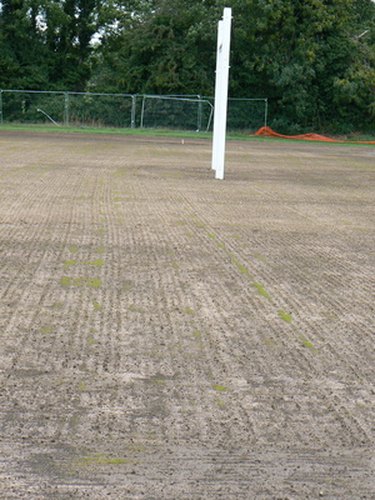
Planting a new lawn from seed is the least expensive method of establishing grass on dirt. Unfortunately, it doesn't come with a sense of instant gratification like sod does, but the whole job is rather easy to complete. Before seeding the lawn, take Sunset Magazine's advice and decide what the primary use of the lawn space will be. Once you know what level of activity the grass will need to sustain and the amount of sunlight or shade it will get, you can purchase the right type of seed.
Step 1
Measure the area to be planted, in square feet, in order to calculate how much seed you'll need.
Video of the Day
Step 2
Plant grass seed in early fall so the seedlings have time to establish a root system before winter. Springtime planting is also acceptable, but planting in the heat and dry weather of summer is more likely to result in failure.
Step 3
Cultivate the bare soil. Because the bare soil has probably been compacted, you'll need to break up the surface so the grass plants' roots can dig in. Sunset Magazine advises that the soil shouldn't be cultivated too finely or else the surface could easily develop a crust that will prevent the seedlings from breaking through; instead the magazine recommends pea-size to marble-size soil particles.
Step 4
Grade the soil. A garden rake is all you need to grade the soil. Your goal is to create a gentle, almost imperceptible, 1 to 2 percent grade so runoff runs downhill from the house and any other buildings. Depending on the size of the area to be seeded, you should grade the lawn up to 50 feet away from the main buildings.
Step 5
Divide the total amount of grass seed for the area in half, as the University of California Extension recommends, place half of it in the seeder (drop, broadcast or handheld spreader) and "sow one half following a vertical pathway and the remaining half horizontally." This will ensure that you completely cover the area with grass seed.
Step 6
Sow the grass seed on a windless day, as Sunset Magazine recommends.
Step 7
Purchase a granular fertilizer formulated for new lawns and apply it to cover the seeded area using a spreader.
Step 8
Cover the seeds. Use the back of a leaf rake and drag it over the soil or apply a 1-inch layer of mulch. Mulch will retain moisture, keep the soil surface from overheating, and keep the grass seeds from washing away when you water them.
Step 9
Keep the soil consistently moist for the next two or three weeks, or until the grass seed has sprouted, after which you can apply more infrequent, deeper waterings. Achieve the right level of moisture by watering the lawn three or four times a day for 5 to 10 minutes.
Video of the Day